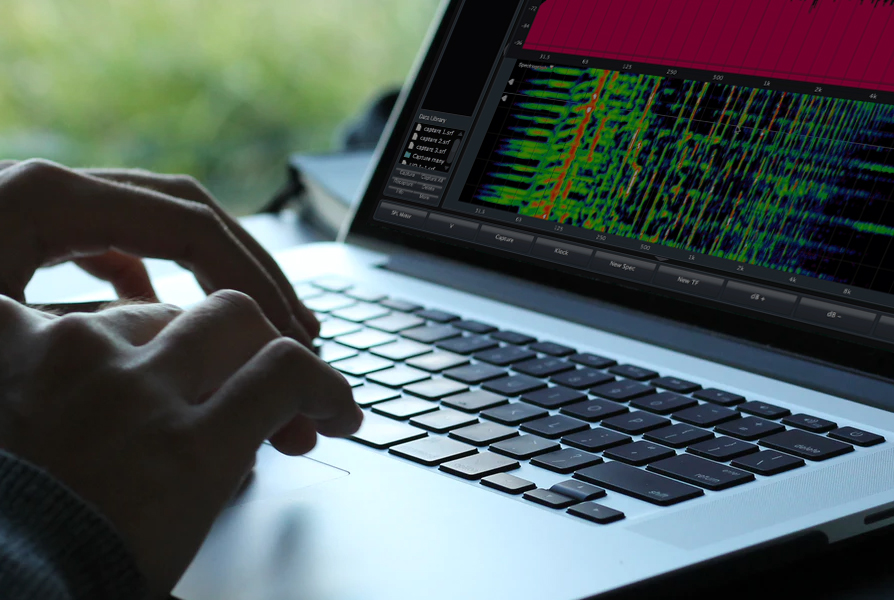Pink noise, white noise, sine waves, square waves, A-weighting, C-weighting… anyone with an interest in sound has come across these terms, but what do they actually mean?
Pink & White Noise
Mixing consoles generally have an onboard pink noise generator that can be used to test signal flow to outputs. But white noise exists as well, so why choose pink, and what’s the difference?
Both pink and white noise contain all of the frequencies audible to human hearing, but the difference lies in the way the energy is distributed. White noise has equal power at every frequency, whereas pink noise decreases in power as we go up the frequency spectrum. So one would think, from that explanation, that white noise would be more useful, right?
Well, no. We’re tuning systems for humans to listen to, and humans do not have a linear, flat, “all frequencies equally welcome” hearing response. Pink noise is simply white noise that’s been filtered to contain the same amount of energy per octave, rather than per frequency. An octave is a frequency band where the highest frequency is double the lowest – i.e., 100 Hz to 200 Hz is one octave; 400 Hz to 800 Hz is one octave; 5 kHz to 10 kHz is one octave. This means that pink noise contains less energy per Hertz at the upper end of the frequency, but because this mirrors the way we hear naturally, we perceive it as being even thanks to our logarithmic perception.
Pink noise became the go-to signal for system tuning back when the real-time analyzer (RTA) was the prevailing tool for the job, because the fractional-octave banding employed by the RTA makes pink noise appear flat. Most modern audio analyzers are source-independent and as a result can use any signal we like.
However, pink noise remains useful because it contains energy at all frequencies, so the measurement can be acquired more quickly than when using music. This is also true for white noise, but it contains half its energy in the top octave (10 kHz to 20 kHz), so it presents an extreme risk of damage to a system’s high-frequency components.
A-Weighting, C-Weighting & Beyond
As noted, human hearing is not linear – and in addition to how we perceive loudness up the spectrum in octaves, our hearing mechanism is most sensitive to frequencies in the upper midrange (Figure 1). This is represented in the equal loudness contours (Figure 2). The diagram — Figure 1 — shows the 0 phon loudness contour, or in other words, the threshold of human hearing. The curve indicates the SPL that a certain frequency must achieve in order for a human to hear it.


For example, note that the 63 Hz tone requires about 30 dB SPL more than the 1 kHz just to be audible. That relationship changes as sound gets louder.
Figure 3 shows the A-weighting and C-weighting curves. A-weighting is a common choice for SPL measurements. (Both see common use because they’re included in the IEC 61672 standard that governs sound level meters.)

When originally created, A-weighting was based on then-
current equal loudness contour research by Fletcher and Munson, and was intended to mimic the tonal response of human hearing at low levels. Although the underlying research is now known to be inaccurate, A-weighting is still commonly used for applications such as noise exposure measurements, where it has been shown that A-weighted SPL measurements correlate well with observed noise-induced hearing loss (NIHL) data. SPL measurements taken with A-weighting are indicated as dB(A).
While it’s still specified in many nuisance noise regulations, it’s a poor choice because the low-frequency rolloff of the A-weighting filter disregards low frequencies – which are the ones that travel the furthest and are the most likely to annoy the neighbors!
The other common choice in live music applications is C-weighting. The story here is similar – although originally intended to mimic the human hearing response at high SPL, the C-weighting curve bears little resemblance to the currently accepted equal loudness contour values. Still, it’s used for SPL measurements where we want to include the LF energy in the measurement – for nuisance noise purposes, for example. C-Weighted measurements are expressed dB(C).
Finally, Z-weighting represents a flat frequency response from 10 Hz to 20 kHz, and measurements are expressed as dB(Z). In the context of live audio, C- and Z-weighted measurements are usually in agreement within a few dB because the differences lie at the extremes of the frequency range.















